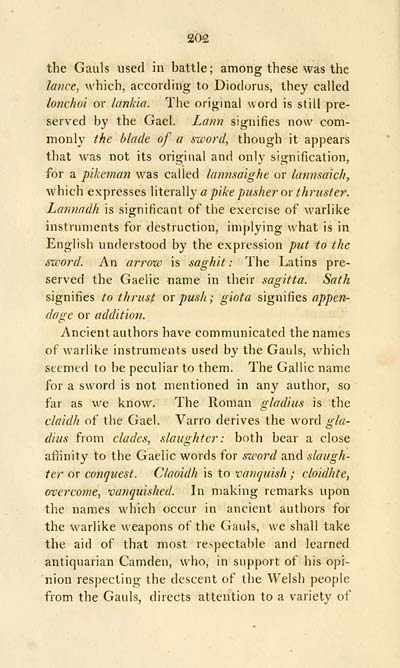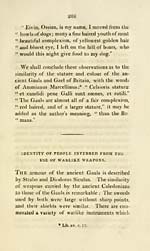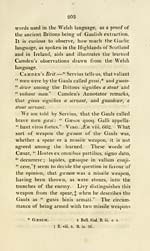Download files
Complete book:
Individual page:
Thumbnail gallery: Grid view | List view

202
the Gauls used in battle; among these was the
latice, which, according to Diodorus, they called
lonchoi or lankia. The original word is still pre-
served by the Gael. Lanfi signifies now com-
monly the blade of a sword, though it appears
that was not its original and only signification,
for a pikeman was called lannsaighe or lannsaich,
which expresses literally a pike pusher or thruster.
Lanundh is significant of the exercise of warlike
instruments for destruction, implying what is in
English understood by the expression put to the
sxvord. An arrow is saghit : The Latins pre-
served the Gaelic name in their sagitta. Sath
signifies to thrust or push ; giota signifies appen-
dage or addition.
Ancient authors have communicated the names
of warlike instruments used by the Gauls, which
seemed to be peculiar to them. The Gallic name
for a sword is not mentioned in any author, so
far as vue know. The Roman gladius is the
claidh of the Gael. Varro derives the word gla-
dius from clades, slaughter: both bear a close
affinity to the Gaelic words for sivord and slaugh-
ter or conquest. Claoidh is to vanquish ; doidhte,
overcome, vanquished. In making remarks upon
the names which occur in ancient authors for
the warlike weapons of the Gauls, we shall take
the aid of that most respectable and learned
antiquarian Camden, who, in support of his opi-
nion respecting the descent of the Welsh people
from the Gauls, directs attention to a variety of
the Gauls used in battle; among these was the
latice, which, according to Diodorus, they called
lonchoi or lankia. The original word is still pre-
served by the Gael. Lanfi signifies now com-
monly the blade of a sword, though it appears
that was not its original and only signification,
for a pikeman was called lannsaighe or lannsaich,
which expresses literally a pike pusher or thruster.
Lanundh is significant of the exercise of warlike
instruments for destruction, implying what is in
English understood by the expression put to the
sxvord. An arrow is saghit : The Latins pre-
served the Gaelic name in their sagitta. Sath
signifies to thrust or push ; giota signifies appen-
dage or addition.
Ancient authors have communicated the names
of warlike instruments used by the Gauls, which
seemed to be peculiar to them. The Gallic name
for a sword is not mentioned in any author, so
far as vue know. The Roman gladius is the
claidh of the Gael. Varro derives the word gla-
dius from clades, slaughter: both bear a close
affinity to the Gaelic words for sivord and slaugh-
ter or conquest. Claoidh is to vanquish ; doidhte,
overcome, vanquished. In making remarks upon
the names which occur in ancient authors for
the warlike weapons of the Gauls, we shall take
the aid of that most respectable and learned
antiquarian Camden, who, in support of his opi-
nion respecting the descent of the Welsh people
from the Gauls, directs attention to a variety of
Set display mode to: Large image | Transcription
Images and transcriptions on this page, including medium image downloads, may be used under the Creative Commons Attribution 4.0 International Licence unless otherwise stated. ![]()
| Early Gaelic Book Collections > Ossian Collection > Thoughts on the origin and descent of the Gael > (214) |
|---|
| Permanent URL | https://digital.nls.uk/82237012 |
|---|
| Description | Selected books from the Ossian Collection of 327 volumes, originally assembled by J. Norman Methven of Perth. Different editions and translations of James MacPherson's epic poem 'Ossian', some with a map of the 'Kingdom of Connor'. Also secondary material relating to Ossianic poetry and the Ossian controversy. |
|---|
| Description | Selected items from five 'Special and Named Printed Collections'. Includes books in Gaelic and other Celtic languages, works about the Gaels, their languages, literature, culture and history. |
|---|

